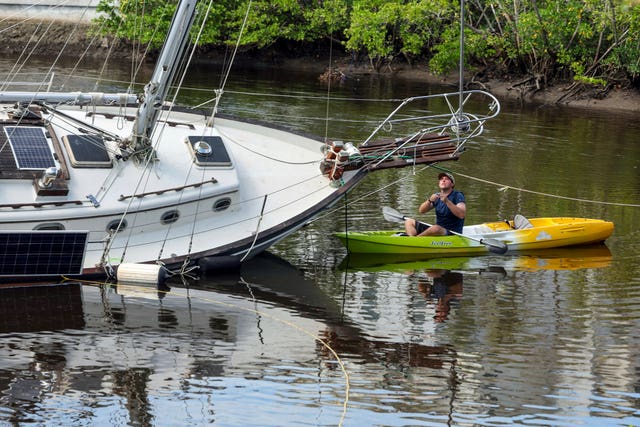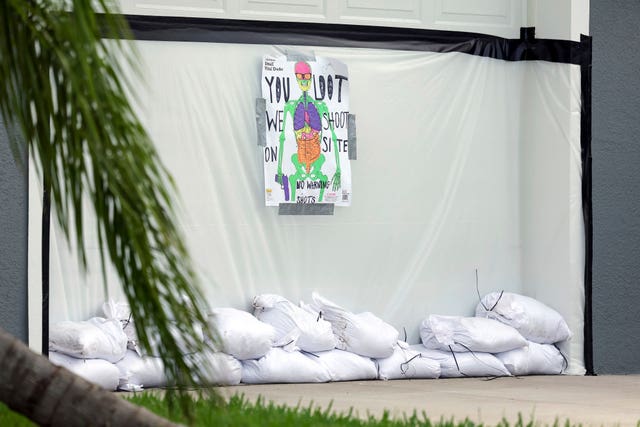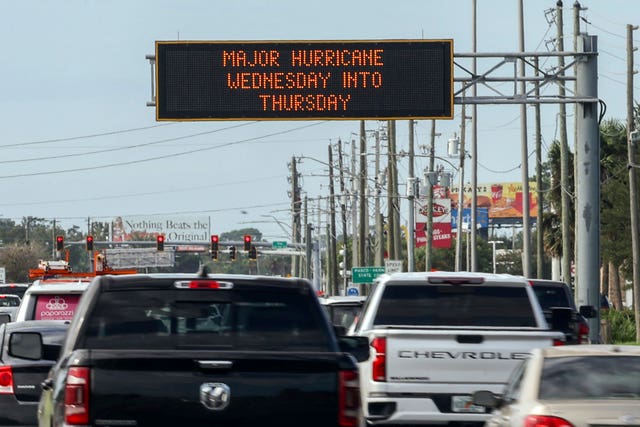Residents warned as Hurricane Milton could land once-in-a-century hit on Florida
Most of Florida’s west coast was under a hurricane or tropical storm warning as the system and its 150 mph winds spun off Mexico’s Yucatan peninsula.

Hurricane Milton weakened slightly on Tuesday but remained a ferocious storm that could land a once-in-a-century direct hit on the populous Tampa Bay region of the US, with towering storm surges and the power to turn debris from Helene’s recent devastation into dangerous projectiles.
Most of Florida’s west coast was under a hurricane or tropical storm warning as the system and its 150 mph winds spun just off Mexico’s Yucatan peninsula, creeping toward shore and sucking energy from the Gulf of Mexico’s warm waters.
With the storm expected to remain fairly strong as it crosses Florida, the hurricane warnings were extended early on Tuesday to parts of the state’s east coast.
The county ordered areas adjacent to the bay and all mobile and manufactured homes to be evacuated by Tuesday night.
“You do not have to get on the interstate and go far away,” governor Ron DeSantis told a news conference, assuring residents there would be enough petrol to fuel their cars for the trip.
“You can evacuate tens of miles. You do not have to evacuate hundreds of miles away. You do have options.”
In the town of Riverview, several drivers waiting in a long line for fuel on Tuesday said they had no plans to evacuate.
“I think we’ll just hang, you know, tough it out,” said Martin Oakes, of Apollo Beach. “We got shutters up. The house is all ready. So this is sort of the last piece of the puzzle.”
Ralph Douglas, of Ruskin, said he, too, will stay put, in part because he worries he would run out of petrol trying to return after the storm or get blocked by debris.
“Where I’m at right now, I don’t think I need to evacuate,” he said.
Mr DeSantis said the state has been scrambling to remove wreckage from Hurricane Helene before Milton strikes, to avoid the risk of flying pieces of debris.
The state has deployed more than 300 lorries that have removed 1,200 loads of debris and continue to work around the clock, he said.

Sheriff’s deputies used a loudspeaker to urge anyone left to escape as soon as possible.
In Clearwater Beach, a fleet of excavators and rubbish trucks got to work to haul away piles of waterlogged couches, mattresses and appliances.
Nick Szabo said he was hired to help clear the roads. His team had hauled away some 260 tons of debris on Monday and planned to keep working all day Tuesday.
Anything left behind will be “like a spear coming at you”, he said.

The National Hurricane Centre downgraded Milton early on Tuesday to a Category 4 hurricane, but forecasters said it still posed “ an extremely serious threat to Florida”.
Milton intensified quickly on Monday, becoming a Category 5 storm for a time.
Forecasters warned that the sea could surge as high as 15 feet at Tampa Bay, leading to evacuation orders for beach communities all along the coast.
In Florida, that means anyone who stays is on their own and emergency services personnel are not expected to risk their lives to rescue them at the height of the storm.
The state has helped evacuate more 200 health care facilities in Milton’s path, and more than 30 county-run shelters are open, Mr DeSantis said.
Milton is forecast to cross central Florida and to dump as much as 18 inches of rain while heading toward the Atlantic Ocean, according to the hurricane centre.
That path would largely spare other states ravaged by Helene, which killed at least 230 people on its path from Florida to the Appalachian Mountains.
Tampa Bay has not been hit directly by a major hurricane since 1921, and authorities fear its luck is about to run out.
President Joe Biden approved an emergency declaration for Florida, and the White House announced on Tuesday that he would postpone a trip to Germany and Angola to monitor Milton, “given the projected trajectory and strength” of the storm.

“People don’t need to move far. They just need to move inland.”
Stragglers were a problem during Helene and Ian in 2022.
Many residents said they evacuated during previous storms only to have major surges not materialise.
But there was evidence on Monday that people were heeding the warnings to get out before Milton arrives.
Vehicles streamed north on Interstate 75, and traffic clogged the southbound lanes for miles as other residents headed for relative safety on the other side of the state, though nearly all of Florida is expected to see some of Milton’s effects.
The National Hurricane Centre on Tuesday extended its storm-surge warning south along Florida’s east coast to Port Canaveral, and a tropical storm watch was issued for the extreme northwestern Bahamas.
About 150 miles south of Tampa, Fort Myers Beach was nearly a ghost town.
Ian devastated the community two years ago with its 15ft storm surge.
Fourteen people died there. On Monday, the few residents who remained raced to safeguard buildings and belongings. None planned to stay.
Signs of Ian remained visible. Rebuilt homes stood next to others in various stages of construction. Construction supplies such as bricks, pipes and workers’ outhouses lined the streets, potential projectiles that could do further damage in a surge or high winds.
At the beach on Monday, workers busily emptied a general store called the Goodz. Owner Graham Belger said he moved his “Your Island Everything Store” into a trailer after Ian destroyed his permanent building across the street.
“We’ll rebuild, but it is going to be bad,” he said.
Meanwhile in Mexico, authorities in the state of Yucatan reported only minor damage from Milton, which remained just offshore early on Tuesday.
Power lines, light poles and trees were knocked down near the coast, and some small thatched-roof structures were destroyed, according to Yucatan governor Joaquin Díaz, but he did not report any deaths or injuries.





